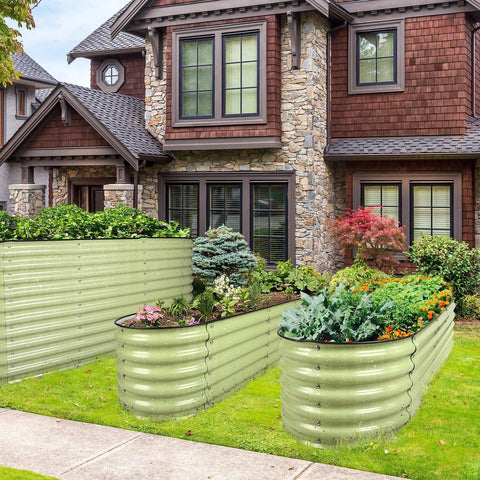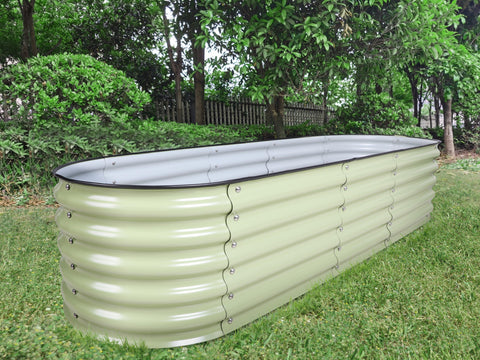Tips from Olle garden beds:The Benefits of Creating Garden Paths Using Raised Beds
Gardening is not just a hobby; it's a rewarding journey that brings us closer to nature while offering numerous physical and mental health benefits. One way to enhance your gardening experience and make it more efficient is by creating garden paths using raised beds. In this article, we'll explore the myriad benefits of incorporating raised beds into your garden paths.
Accessibility and Ergonomics
Garden paths lined with raised beds provide a practical solution for those who may struggle with traditional ground-level gardening. Raised beds elevate the soil, reducing the need for bending, kneeling, or stooping. This accessibility makes gardening more inclusive, regardless of age or physical ability. Gardeners with mobility issues can now enjoy the therapeutic benefits of gardening without discomfort.
Improved Drainage and Soil Quality
One of the key advantages of raised beds is the control they provide over soil quality and drainage. By elevating the planting area, you can ensure that your garden soil drains properly, preventing waterlogged roots and soil erosion. Additionally, you have greater control over the composition of the soil, allowing you to customize it to suit the specific needs of your plants. This results in healthier, more productive gardens.
Extended Growing Seasons
Raised beds tend to warm up faster in the spring, allowing you to start planting earlier in the season. This extended growing season means you can enjoy fresh produce sooner and for a longer duration. It's a fantastic advantage for gardeners in regions with shorter growing seasons or unpredictable weather patterns.
Weed and Pest Management
Garden paths created with raised beds offer a natural defense against weeds. The defined borders make it easier to spot and remove unwanted plants, reducing the competition for resources. Additionally, raised beds can be lined with various materials, such as landscape fabric, which further inhibits weed growth. Elevated beds also deter some garden pests and make it more challenging for critters to access your precious plants.
Enhanced Aesthetics
Beyond the practical advantages, raised beds can significantly improve the aesthetics of your garden. They create clean lines and visually distinct planting areas, making your garden more organized and visually appealing. The elevated beds add dimension to your landscape design and can be creatively integrated into your overall garden layout.

Efficient Space Utilization
When you create garden paths using raised beds, you make the most of your available space. These beds can be designed to fit your specific garden dimensions, allowing you to maximize your growing area while still providing easy access to all plants. This efficient use of space is especially beneficial for those with limited gardening real estate.
Easier Maintenance
Maintaining a garden with raised beds and paths is generally less labor-intensive. The clearly defined borders make it simpler to weed, water and care for your plants. It's also easier to amend the soil or add compost when needed, as you're working within a contained space.
Versatility in Design
Raised beds offer a world of design possibilities. You can choose from various materials like wood, stone, or metal to match your garden's aesthetic. You can also experiment with different heights, shapes, and configurations to create a unique and personalized garden path that reflects your style and preferences.
Incorporating raised beds into your garden paths is a practical and aesthetically pleasing choice that brings numerous benefits to your gardening experience. From improved accessibility and soil quality to extended growing seasons and enhanced aesthetics, these beds are a versatile and efficient way to elevate your garden game. So, why wait? Transform your garden into a green paradise with raised beds, and enjoy the many advantages they offer. Happy gardening!
Raised beds not only define the pathway but also provide an opportunity to grow a variety of plants, herbs, and flowers. In this article, we'll guide you through the process of creating enchanting garden paths using raised beds, turning your garden into a breathtaking oasis of beauty and tranquility.
Step 1: Plan Your Pathway
Before you begin building raised beds for your garden path, it's crucial to plan the layout carefully. Consider the following:
Pathway Design: Decide on the shape, width, and flow of your garden path. Curved paths can add a sense of intrigue and lead visitors on a journey through your garden.
Materials: Choose the materials for your raised beds and pathway. Common options include wood, stone, brick, or concrete blocks. Make sure the materials complement the style of your garden.
Sunlight: Take note of how much sunlight each section of the path receives, as this will influence your plant choices.
Plant Selection: Plan what types of plants you want to grow in your raised beds. Consider the height, color, and seasonal interest of each plant to create a visually appealing path.
Step 2: Build Your Raised Beds
Once you've finalized your pathway design, it's time to construct the raised beds. Follow these steps:
Measure and Mark: Use stakes and string to outline the path's edges and the location of the raised beds. Make sure the dimensions are consistent and visually pleasing.
Select Bed Materials: Choose your preferred materials for the raised beds. Wood is a popular choice for its natural look, but be sure to use rot-resistant types like cedar or redwood. Alternatively, use stone, brick, or concrete blocks for a more permanent and structured look.
Level the Ground: Ensure that the ground beneath the raised beds is level. Use a shovel and a level to create a solid foundation for the beds.
Assemble Beds: Construct the raised beds according to your chosen design, securing the corners with screws or mortar for stone or brick beds.
Fill with Soil: Fill the beds with a quality garden soil mix, rich in organic matter, to provide a healthy environment for your plants.

Step 3: Plant Your Raised Beds
Now comes the exciting part – planting your raised beds to create an enchanting garden path. Here are some tips:
Consider Height: Place taller plants towards the back of the bed and shorter ones at the front. This provides a sense of depth and allows all plants to receive sunlight.
Mix Textures and Colors: Incorporate a variety of plant textures and colors to make the garden path visually captivating. For example, mix flowering plants, ornamental grasses, and herbs.
Think Seasonally: Plan for year-round interest by choosing plants that bloom or display foliage at different times of the year. This ensures your garden path remains beautiful in every season.
Maintenance: Be mindful of the maintenance requirements of each plant. Some may need regular pruning, while others may thrive with minimal care.
Step 4: Pathway Construction
With the raised beds in place and your plants thriving, it's time to finish your garden path:
Path Material: Lay down your chosen pathway material, whether it's gravel, stepping stones, or mulch. This will create a clear separation between the raised beds and provide a safe walking surface.
Edging: Install edging along the sides of the path to keep the materials in place and add a polished look to your garden.
Illumination: Consider adding pathway lighting to enhance the beauty of your garden path during the evening hours.
Step 5: Enjoy and Maintain
Your garden path with raised beds is now complete. Regularly water, weed, and care for your plants to keep them healthy and vibrant. Trim any overgrown branches or plants that may obstruct the path. With proper maintenance, your garden path will continue to enchant and delight you and your visitors for years to come.
Creating garden paths with raised beds is a fantastic way to combine form and function in your outdoor space. With careful planning and attention to detail, you can transform your garden into a breathtaking oasis that reflects your personality and gardening prowess. So, roll up your sleeves, put on your gardening gloves, and get ready to embark on the journey of creating an enchanting garden path that will be the envy of all who visit.
